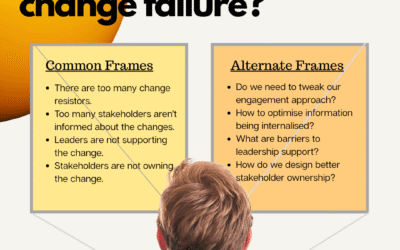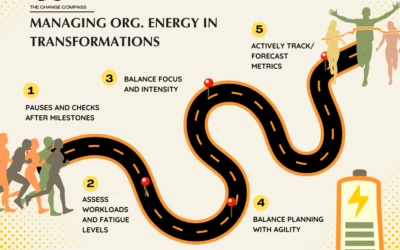Central to many contemporary approaches to agile change management is the concept of “failing fast.” This idea, popularized by agile methodology, suggests that failure is not only acceptable but desirable, as it provides valuable insights that can inform subsequent iterations and improvements. While the intention behind failing fast is noble—to accelerate learning and increase the likelihood of success—it’s essential for change practitioners to critically examine this notion and consider if this actually works.
We’ll explore the nuances of failing fast within the context of change and transformation initiatives. Drawing upon insights from research, real-world experiences, and best practices, we’ll delve into the complexities of learning from both success and failure. We will explore the myth of failing fast and discuss practical actions that can help change practitioners improve the change outcome success.
Understanding the Myth of Failing Fast
At its core, the concept of failing fast is rooted in the belief that failure is an inevitable part of the innovation process. By embracing failure and learning from it, organizations can iterate more quickly, adapt to changing circumstances, and ultimately increase their chances of success. However, the reality can often be far more complex.
Research has shown that failure is not always a reliable teacher. Psychological barriers, such as ego and fear of failure, can hinder the learning process and prevent individuals from extracting meaningful insights from their experiences. Moreover, the correlation between failure and success is not linear—simply experiencing failure does not guarantee future success.
Research by Lauren Eskreis-Winkler and Ayelet Fishbach showed that failure may not always be a good teacher, often because ego gets in the way. Eskreis-Winkler and Fishbach write that failure can be a big hit to one’s ego, which may reduce motivation. And when the researchers removed ego from the equation by having some people learn from others’ wrong answers, not their own, participants learned equally from failures and successes. “Because people find failure ego-threatening, they will disengage from the experience, which means they stop paying attention, or, tune out,” the researchers write (for more check out the Chicago Booth Review article).
Also, learning from failure requires the person to be open enough and aware enough to notice the potential causes of the failure. Not all leaders are in this category. There may also be hundreds of reasons for failure and so attributing particular causes that directly led to the failure may not always be easy.
For more research on the myth of failing fast check out this article that reviewed research on failed companies and industries.
For change and transformation practitioners, it’s essential to approach the notion of failing fast with a critical eye. While failure can certainly provide valuable lessons, it should not be glorified or pursued at the expense of achieving meaningful outcomes. Instead, change practitioners should strive to create an environment where both success and failure are celebrated as opportunities for learning and growth.
Embracing a Balanced Approach to Learning
Rather than focusing exclusively on failing fast, change practitioners should adopt a more balanced approach to learning—one that encompasses both success and failure. This entails recognizing that success can be just as instructive as failure and that meaningful insights can be gleaned from a variety of experiences.
One effective strategy for embracing a balanced approach to learning is to leverage the retro process following both successful and unsuccessful change initiatives. By examining the factors that contributed to the outcome—whether positive or negative—change practitioners can identify key insights and lessons learned that can inform future efforts.
Amy Edmonson, in her booked titled “Right Kind of Wrong” makes a case for learning from “intelligent failure” with the four following attributes …”it takes place in new territory, the context presents a credible opportunity (in relation to risk) to advance toward a desired goal, it is informed by available knowledge, and finally the failure is as small as it can be to still provide valuable insights” (to read more check out the HBR article).
Additionally, change practitioners should cultivate a culture of psychological safety within their organizations, where individuals feel empowered to take risks, experiment with new ideas, and share their experiences openly. This not only promotes knowledge sharing and collaboration but also fosters a mindset of continuous improvement and innovation.
Leveraging Success as a Learning Opportunity
While failure often receives more attention in discussions about learning and innovation, success can be equally instructive. When a change initiative achieves its intended outcomes, it’s important for change practitioners to reflect on the factors that contributed to that success and identify best practices that can be replicated in future endeavours.
There is also plenty of evidence that support a ‘strength-based approach’ to learning and development, i.e. focusing on what a person does well and has had successes in. This approach focuses on extending the strength of a person rather than focuses on the weaknesses. Check out the Gallup article on creating a strengths-based culture.
One effective strategy for leveraging success as a learning opportunity is to document and share success stories within the organization. By highlighting examples of successful change initiatives and the strategies that led to their success, change practitioners can inspire and motivate others to adopt similar approaches in their own work.

Change practitioners should encourage a mindset of continuous improvement among their teams, where success is viewed not as an endpoint but as a milestone on the journey toward excellence. By celebrating successes and acknowledging/reinforcing the hard work and dedication of stakeholders, change practitioners can reinforce positive behaviours and drive sustained performance.
Integrating Learning into the Change Management Process
Learning should be an integral part of the change management process, woven seamlessly into each phase of the initiative. From the initial planning stages to implementation and beyond, change practitioners should prioritize reflection, feedback, and continuous improvement to drive successful outcomes.
During the planning phase, change practitioners should conduct thorough research and analysis to identify potential risks and challenges and develop strategies to mitigate them. Learn from what has or has not worked in the past. By incorporating lessons learned from past experiences, change practitioners can increase the likelihood of success and avoid common pitfalls.
During the implementation phase, change practitioners should monitor progress closely and adapt their approach as needed based on real-time feedback and data. By remaining flexible and responsive to changing circumstances, change practitioners can optimize their strategies and increase their chances of achieving their objectives.
Following the completion of a change initiative, change practitioners should conduct a comprehensive review to evaluate the outcomes and identify areas for improvement. By soliciting feedback from stakeholders and conducting a thorough analysis of the results, change practitioners can extract valuable insights that can inform future efforts and drive continuous improvement.

In the ever-evolving landscape of change and transformation, the ability to learn from both success and failure is essential for driving meaningful outcomes. While the concept of failing fast has gained popularity in recent years, change practitioners must recognize its limitations and adopt a more balanced approach to learning—one that values both success and failure as opportunities for growth and improvement.
By embracing a culture of continuous improvement, fostering psychological safety, and integrating learning into every phase of the change management process, change practitioners can position their organizations for success in an increasingly competitive and uncertain environment. By leveraging the insights gained from both successes and failures, change practitioners can drive meaningful change and transformation within their organizations, ultimately leading to sustained growth and success.






